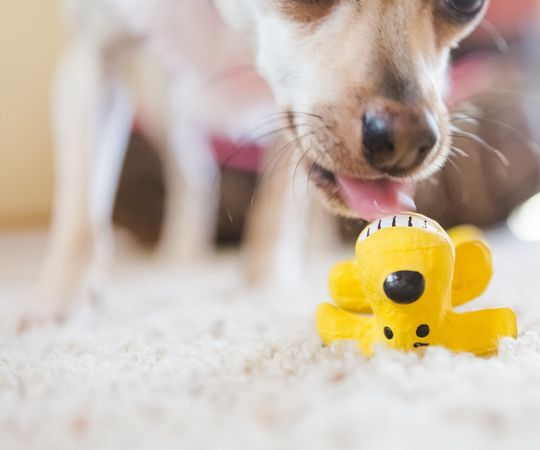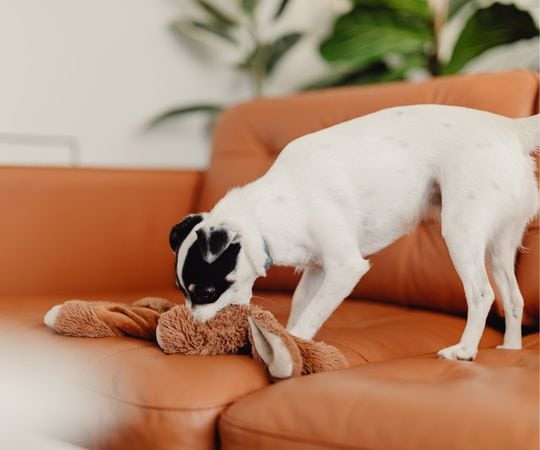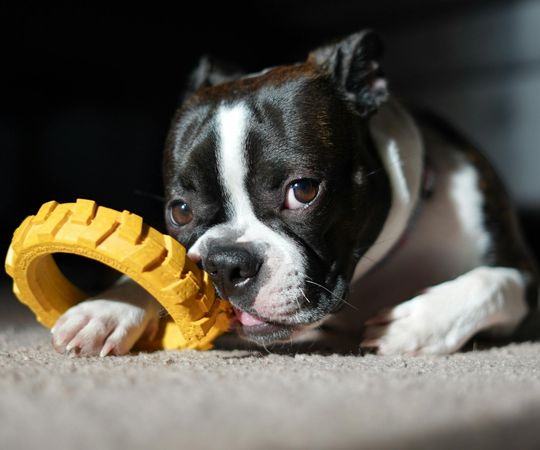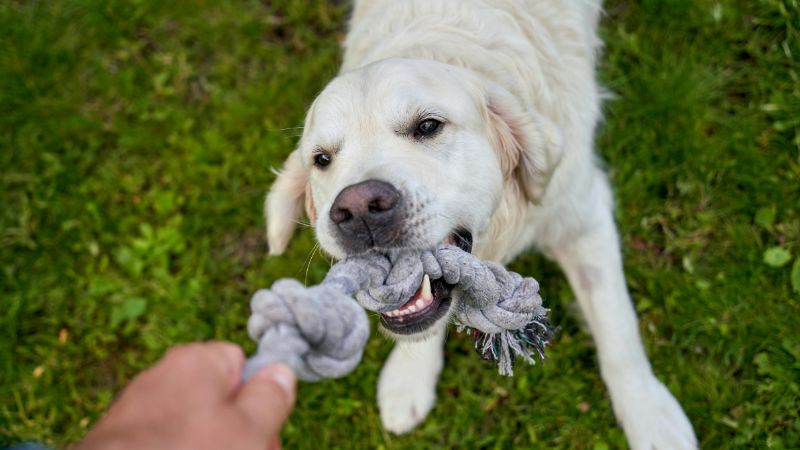
إذا سبق لك أن لعبتَ شد الحبل مع كلبك، فأنتَ تُدرك مدى حبّه لها. هذه اللعبة الشيقة تُثير غرائزه الفطرية، فتُتيح له إطلاق العنان لمفترسه الكامن بينما يستمتع معك. على عكس الاعتقادات الخاطئة الشائعة، فإن شد الحبل لا يُعزز العدوانية، بل يُعزز الرابطة بينكما ويُشجّع على ضبط انفعالاتكما.
الكلاب تزدهر بالتفاعل واللعب، ولعبة شد الحبل تُتيح فرصة فريدة للتعاون. هذه اللعبة عالية الطاقة مثالية للتخلص من الطاقة الزائدة، خاصةً في الأيام الممطرة التي لا يكون فيها اللعب في الهواء الطلق خيارًا متاحًا. إن فهم سبب استمتاع جروك بهذه اللعبة يُعزز تواصلك معه ويُحسّن صحته العامة.
لماذا تحب الكلاب لعبة شد الحبل؟
تحب الكلاب لعبة شد الحبل لأسباب عديدة، أبرزها غرائزها الطبيعية والطبيعة الاجتماعية للعبة. فهم هذه الدوافع يُعزز الرابطة بينكما ويجعل وقت اللعب أكثر متعة.
الغرائز المفترسة الطبيعية
شد الحبل هو منفذ مباشر لغريزة الافتراس لدى الكلب، وهي غريزة تُعرف غالبًا باسم "غريزة الفريسة". هذا النمط السلوكي الفطري، المُكتسب في الكلاب عبر قرون من التطور، يشمل المطاردة، والمطاردة، والإمساك، والهز، والسحب. عندما يُمسك كلبك بحماس بلعبة شد الحبل، فإنه يُؤدي المراحل الأخيرة والمُجزية من هذه السلسلة. يُحاكي هز الرأس القوي الحركة المُستخدمة للتخلص من الفريسة الصغيرة، بينما يُمثل السحب للخلف المطالبة المنتصرة بالجائزة.
بالنسبة للسلالات ذات الخلفيات القوية في تربية الكلاب أو تربية الكلاب من نوع تيرير، تُعدّ هذه اللعبة طريقة آمنة ومُرضية للغاية للتعبير عن هذه الرغبات الفطرية دون أي عواقب واقعية. فهي تُحوّل لعبة يومية إلى هدف محاكاة للصيد، مما يُعطي شعورًا عميقًا بالهدف والإنجاز.
القرب الفطري للكلاب
الكلاب كائنات اجتماعية بطبيعتها، وترغب بطبيعتها في التقرب من أصحابها. تنبع هذه الرغبة من عدة عوامل مرتبطة بتاريخها التطوري وتطورها مع البشر. إليكم الأسباب.
- الارتباط والترابط: الكلاب حيوانات اجتماعية للغاية، وتُكوّن روابط قوية مع مُقدّمي الرعاية لها. وغالبًا ما تنظر إلى أصحابها البشر على أنهم مجموعتها الاجتماعية الأساسية. يمنحها هذا الرابط شعورًا بالأمان والراحة والانتماء.
- الرفقة والمودة: تتوق الكلاب إلى الرفقة والعاطفة. وغالبًا ما تسعى إلى القرب الجسدي، أو الاتكاء، أو الدفع، أو الاحتضان مع أصحابها، كطريقة للتعبير عن عاطفتها ونيل الراحة.
- الاعتماد على الاحتياجات: تعتمد الكلاب على أصحابها في احتياجاتها الأساسية، كالطعام والماء والمأوى والأمان. هذا الاعتماد يُعزز رابطة قوية بينها وبين مُعيلها، ويشجعها على البقاء بالقرب منه.
- التعزيز الإيجابي: غالبًا ما يُقدّم أصحاب الكلاب تعزيزات إيجابية، كالتربيت والثناء والمكافآت واللعب، عندما تكون قريبة منهم. هذا يُعزّز سلوك البحث عن القرب ويقوّي الرغبة في البقاء بالقرب منهم.
- التاريخ التطوري: على مدى آلاف السنين من التطور المشترك مع البشر، رُبِّيت الكلاب انتقائيًا وتكيفت للعيش جنبًا إلى جنب مع البشر. وقد غرست هذه العملية فيها ميلًا طبيعيًا للاقتراب من البشر.
فوائد لعب شد الحبل
تُقدّم لعبة شد الحبل فوائد عديدة لكلبك، فهي تُحسّن صحته البدنية وتُقوّي علاقتكما. المشاركة في هذه اللعبة التفاعلية تُرضي غرائزه وتُحسّن صحته العامة.
التحفيز البدني والعقلي
أبعد من الغريزة، يُعدّ شد الحبل نشاطًا مُجزيًا وممتعًا للغاية، يُوفّر تحفيزًا ذهنيًا وجسديًا حيويًا. اللعبة عبارة عن تمرين كامل للجسم، يُشغّل عضلات الكلب، ويُحسّن تناسقه، ويُرهق جهازه القلبي الوعائي. عقليًا، يتطلب تركيزًا شديدًا، واستراتيجية، ومهارات حل المشكلات، بينما يُحسّن الكلب قبضته وقدرته على الرفع لتحقيق أفضلية. متعة النضال بحد ذاتها مكافأة، لكن فرصة "الفوز" باللعبة في النهاية تُضفي شعورًا قويًا بالإنجاز. هذا المزيج من الجهد البدني والتحدي المعرفي يجعل لعبة شد الحبل المُنظّمة واحدة من أكثر الطرق فعالية ومتعة لحرق الطاقة الزائدة، وغالبًا ما تكون أكثر إرهاقًا من المشي لمسافات طويلة.
تعزيز العلاقة بين الإنسان والكلب
وأخيرًا، ولعلّ الأهم من ذلك، تُعدّ لعبة شد الحبل طقسًا اجتماعيًا قويًا لتعزيز الترابط بين الكلب وصاحبه. في بيئة منزلية، تتيح لك هذه اللعبة أنت وكلبك المشاركة في لعبة تفاعلية. خلال هذه اللعبة، يُدرك كلبك أنه يلعب، مما يُعزز الرابطة بينكما من خلال العمل الجماعي.
يساعد التواصل والعمل الجماعي في لعبة الشد على تعليم كلبك القواعد والحدود. فعندما تُلعب بقواعد ثابتة، يتحول الأمر إلى حوار شد وجذب يتطلب مشاركة متبادلة. يتعلم كلبك أن ينظر إليك للحصول على الإشارات والتوجيه، مما يعزز دورك كقائد خير. بإطاعة أوامر مثل "انسَها" وملاحظة أن الامتثال يؤدي إلى استمرار المتعة، يتعلم جروك ضبط انفعالاته بشكل قيّم، وأن التعاون معك هو مفتاح كل خير.
هذا التفاعل الفردي يمنح كلبك اهتمامًا مُركّزًا، ويُعزّز مشاعر التواصل والثقة لديه. هذا يُحوّل اللعبة من مُسابقة بسيطة إلى تفاعل مُنظّم يُعمّق الاحترام والتواصل والاستمتاع المُتبادل، مُعزّزًا بذلك الشراكة الفريدة التي نتشاركها مع كلابنا.
المفاهيم الخاطئة الشائعة حول لعبة شد الحبل
تحيط العديد من المفاهيم الخاطئة بلعبة شد الحبل، مما يدفع أصحاب الكلاب غالبًا إلى تجاهل هذه اللعبة الشيقة. يساعد فهم هذه المفاهيم الخاطئة على توضيح فوائد وإرشادات لعب شد الحبل مع كلبك.
الاعتقاد الخاطئ الأول: أنه يسبب العدوان
- الأسطورة: إن لعب لعبة شد الحبل سيجعل كلبك عدوانيًا، أو مهيمنًا، أو "ألفا" عليك.
- الحقيقة: هذه هي الخرافة الأكثر شيوعًا والأكثر دحضًا. لعبة شد الحبل لا تُسبب العدوانية، بل تُحوّل الطاقة الكامنة إلى لعبة مُنظّمة. العدوانية مسألة مُعقّدة تنبع من الخوف أو القلق أو ضعف التنشئة الاجتماعية، وليست لعبة ذات قواعد. في الواقع، تُعلّم لعبة شد الحبل المُدارة جيدًا كلبك ضبط انفعالاته وكيفية اللعب بأدب مع البشر.
الاعتقاد الخاطئ الثاني: السماح لكلبك "بالفوز" يشجع على الهيمنة
- الأسطورة: إذا فاز الكلب باللعبة، فإنه سوف يعتقد أنه مهيمن عليك.
- الحقيقة: الفوز مُعزِّزٌ قوي. إن السماح لكلبك بالفوز يُبقي اللعبة مُثيرة ويُحفِّزه على اللعب مُجددًا. فهو يُعزِّز ثقته بنفسه، ويُمثِّل طريقةً رائعةً لإنهاء الجلسة بحماس. السر هو أن أنت التحكم في اللعبة و أنت تحديد متى يفوزون، وتعزيز دورك كمقدم للمتعة، وليس كمنافس على المكانة.
الاعتقاد الخاطئ الثالث: إنه سيء لأسنانهم
- الأسطورة: إن السحب والهز قد يؤدي إلى إتلاف أسنان أو فك الكلب.
- الحقيقة: هذا صحيح فقط إذا كنت تستخدم لعبة غير مناسبة (مثل عصا صلبة أو لعبة حادة) أو تلعب بتهور. عند اللعب بلعبة شد ناعمة مناسبة (مثل حبل أو قطعة مطاطية)، يكون ذلك آمنًا تمامًا على أسنان كلبك السليمة. استشر طبيبك البيطري دائمًا إذا كان كلبك يعاني من مشاكل أسنان سابقة.
كيفية لعب لعبة شد الحبل بأمان مع كلبك
يمكن أن تكون لعبة شد الحبل مع كلبك تجربة ممتعة ومجزية. اتبع هذه الإرشادات لضمان لعب آمن وفعال.
اختيار اللعبة الصحيحة
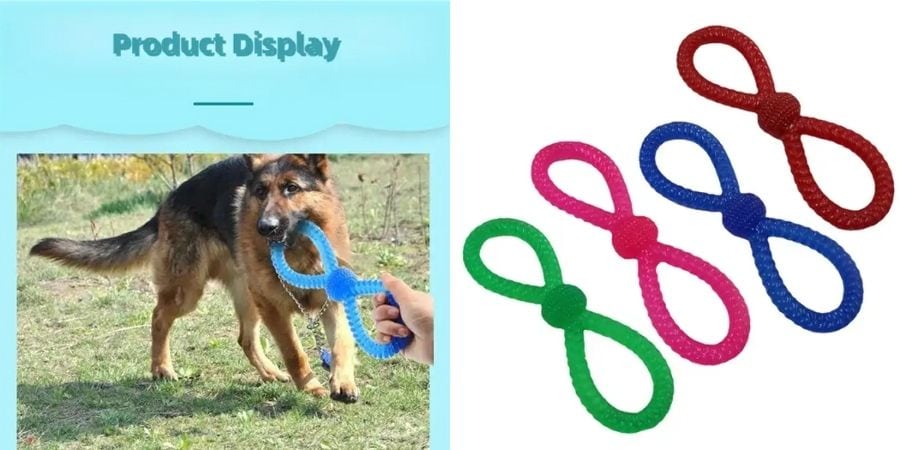
اختر لعبة شد مصنوعة من مواد قوية مثل المطاط أو القماش المتين الذي لا يتآكل. يجب أن تكون اللعبة الحجم المناسب لفم وقوة كلبك. الألعاب الناعمة توفر خيارات آمنة للعب الأقل شدة، بينما تتحمل الألعاب المطاطية شدًا أقوى. تجنب الألعاب التي قد تتفكك بسهولة أو تُشكل خطر الاختناق. فكّر في إدخال ألعاب تحتوي على القوام المصممة للمساعدة في تنظيف أسنان كلبك. أعطِ الأولوية المتانة والسلامة حسب اختيارك لتعزيز تجربة السحب.
وضع قواعد اللعبة وإشارات النهاية
ضع قواعد واضحة قبل بدء لعبة شد الحبل. استخدم كلمة أمر، مثل "شد الحبل"، للإشارة إلى بدء اللعب. تأكد من إمساكك أنت وكلبك باللعبة بإحكام لتجنب الإصابات العرضية. علّم كلبك أمر تحرير، مثل "أسقطها"، ليحدد متى يجب عليه تركها. إذا لمس كلبك يدك أو جلدك بأسنانه دون قصد أثناء اللعب، أوقف اللعبة فورًا لتأكيد أن العض غير مقبول. اجعل الجلسات قصيرة ومثيرة، لا تتجاوز مدتها 5 إلى 10 دقائق، للحفاظ على التفاعل ومنع التحفيز المفرط. تعزز القواعد الثابتة الفهم وتحافظ على تجارب إيجابية لك ولكلبك.
خاتمة
لعبة شد الحبل ليست مجرد لعبة؛ إنها فرصة لك ولكلبك لتوطيد علاقتكما وإشباع غرائزهما الفطرية. المشاركة في هذا النشاط الممتع لا توفر تمرينًا بدنيًا فحسب، بل تعزز أيضًا التواصل والثقة بينكما. بوضع القواعد والحدود، يمكنكما ضمان أن تبقى لعبة شد الحبل تجربة إيجابية تُعزز علاقتكما.
تذكر أن اختر الألعاب المناسبة اجعل جلسات اللعب ممتعة وآمنة. فالفرح الذي يشعر به كلبك خلال هذه الأوقات يُسهم في سعادته ورفاهيته بشكل عام. لذا، أحضر لعبة حبل متينة واستمتع بإثارة شد الحبل مع صديقك الفروي.
الأسئلة الشائعة
لماذا تحب الكلاب لعبة شد الحبل كثيرًا؟
تنجذب الكلاب غريزيًا إلى لعبة شد الحبل لأنها تُثير غريزتها في اصطياد الفرائس. تُحاكي اللعبة إثارة مطاردة الفريسة وأسرها، وهو أمرٌ مُثيرٌ لها. كما تُتيح اللعبة منصةً للتفاعل الاجتماعي وتُعزز الرابطة بينك وبين كلبك من خلال العمل الجماعي.
هل من المفترض أن تدع الكلب يفوز في لعبة شد الحبل؟
نعم، إن السماح لكلبك بالفوز أثناء لعبة شد الحبل مفيد. فهو يعزز ثقته بنفسه ويبقيه منشغلاً. بإبعاد اللعبة عنه بعد شد قوي، يمكنك الاحتفال بفوزه، مما يعزز رابطتكما ويمنع أي شعور بالإحباط.
ما هي المدة التي يجب أن تلعب فيها لعبة شد الحبل مع الكلب؟
يجب أن تكون جلسات لعب شد الحبل قصيرة، ويفضل أن تتراوح مدتها بين 5 و10 دقائق. تساعد هذه المدة على الحفاظ على اهتمام كلبك وحماسه، مع منع الإفراط في التحفيز أو التعب. راقب دائمًا مستويات طاقته، وخذ فترات راحة عند الحاجة.
هل من الصحي أن تلعب لعبة شد الحبل مع كلبك؟
بالتأكيد! تُقدم لعبة شد الحبل تمرينًا بدنيًا ممتازًا، حيث تُقوي عضلات رقبة كلبك وفكه. كما تُوفر تحفيزًا ذهنيًا، مما يُساعد على تخفيف الملل. عند اللعب بها وفقًا للقواعد والأنظمة، يُمكن أن تُعزز علاقة صحية بينك وبين كلبك.
كيف يمكنني ضمان ألعاب شد الحبل الآمنة مع كلبي؟
لضمان السلامة أثناء لعبة شد الحبل، اختر ألعابًا متينة ومناسبة لحجم كلبك. ضع قواعد واضحة واستخدم الأوامر لبدء اللعبة وإنهائها. اجعل الجلسات قصيرة للحفاظ على التفاعل ومنع التحفيز المفرط، مما يضمن تجربة ممتعة لكليكما.

